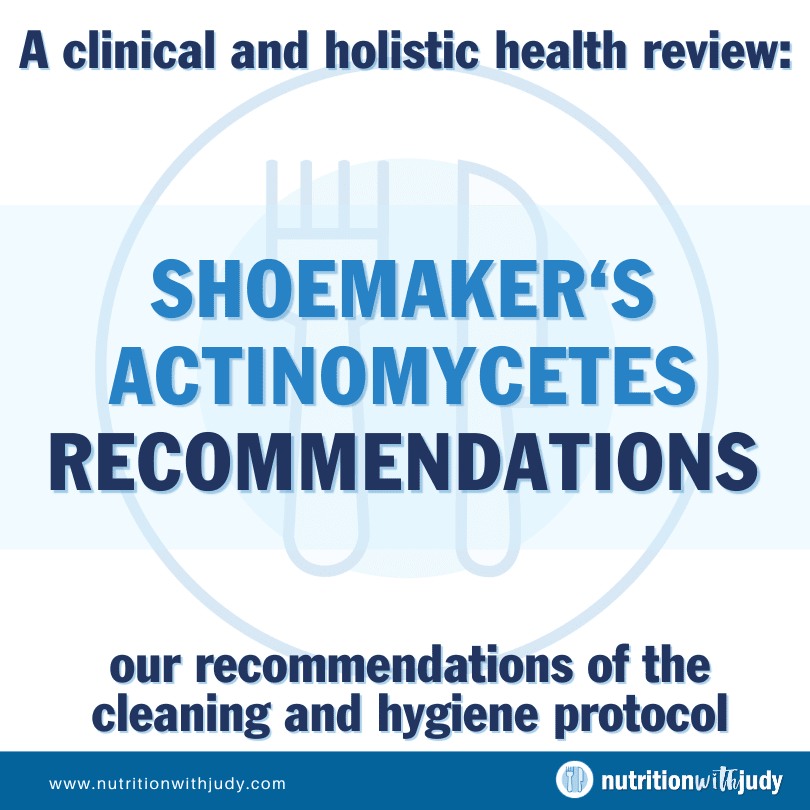

Exploring Shoemaker Actinos Recommendations: Our Stance On the Current Actinos Cleaning and Hygiene Protocol


The heart of our practice has always focused solely on finding root-cause healing for our patients. Throughout many years of clinical practice, the carnivore diet acted as a foundational tool that either achieved root-cause healing alone or supported our patients as they continued searching for their root cause.
As we soon discovered that a meat-based diet can heal a lot but not everything, we eventually found a significant missing piece that seemed more prevalent in our community. Environmental illness from mold exposure, tick bites, algae blooms, and other biotoxins was discovered to be a critical piece for many of our chronically ill patients.
This led us to Chronic Inflammatory Response Syndrome (CIRS), a complex multi-system, multi-symptom disease caused by whole-body inflammation due to an overactive immune response. The CIRS protocol, subsequent data, and ongoing research were pioneered by Dr. Ritchie Shoemaker, offering the only peer-reviewed, clinically replicable protocol for treating mold illness and other biotoxin exposure.
After digging into all the research available and seeing some of the incredible healing from the Shoemaker Protocol firsthand, I became certified as a Shoemaker Proficiency Partner Diplomate. I spent several months training our team to better serve our patients and ensure the highest-quality holistic care needed by our chronically ill community.
Hundreds of our patients have received a confirmed CIRS diagnosis and are currently undergoing the Shoemaker Protocol. While this process has been straightforward for some, we’ve observed confusion and setbacks regarding the actinomycetes (actinos) portion of this illness.
To better support our patients in active treatment, we went down the actinos rabbit hole to examine the present state of CIRS’ actinos research and whether the current actinos protocol is effective. With so many of our patients struggling to reduce their environmental actinos and not improving in symptoms even when consistently sticking to the recommended actinos cleaning and hygiene, we knew we had to dig deeper.
Let’s take a closer look at the current Shoemaker actino recommendations, the data behind these protocols, and our stance for holistically supporting our patients.
Disclaimer: We don’t advise changing course if you feel good with your current actinos cleaning and hygiene protocol. We adhere to the principle, ‘If it isn’t broken, don’t fix it,’ believing in the value of maintaining what already works well. That being said, we advise anyone using harsher products such as Fantastik or Medicasp for an extended period to consider switching to more natural, beneficial alternatives for supporting overall health.
What Is Chronic Inflammatory Response Syndrome?
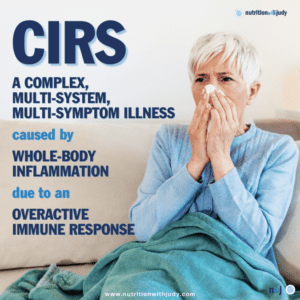

CIRS is a complex, multi-system, multi-symptom disease caused by whole-body inflammation due to an overactive immune response. CIRS is a legitimate medical diagnosis that requires specific lab testing and patient history analysis in order to verify.
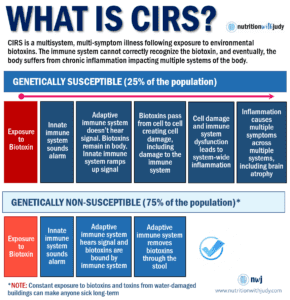

Since CIRS symptoms can vary so differently from patient to patient, many are misdiagnosed or left untreated. Unlike other immunity disorders that can be characterized by an inappropriate adaptive immune response, CIRS can’t be identified by traditional autoimmune blood markers. It requires a five-step diagnostic criteria process to be confirmed. You can learn more in-depth about CIRS here.
What Are Actinomycetes?
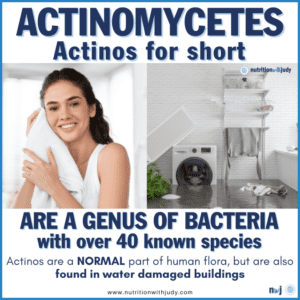

Actinomycetes, or actinos, are a genus of bacteria that play a pivotal role in both the natural environment and human health. There are more than 40 known species of actinos— all of which are considered gram-positive bacteria and don’t contain an outer membrane.
These bacteria are not only part of the human body’s normal flora, aiding in the decomposition of organic substances in the mouth and other regions, but they also significantly impact various ecosystems, especially in water-damaged buildings (WDBs). Actinos is one of the components of the biochemical stew found in water-damaged buildings.
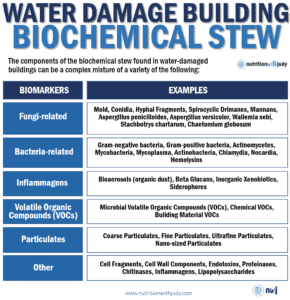

In water-damaged buildings, actinos contribute to the breakdown and degradation of organic materials, highlighting their role in the ecological decomposition process. However, their ability to thrive in damp, damaged structures can pose health risks to humans, leading to the development of actinos when these bacteria invade human tissues through breaches in mucosal barriers or skin.
Actinos and CIRS
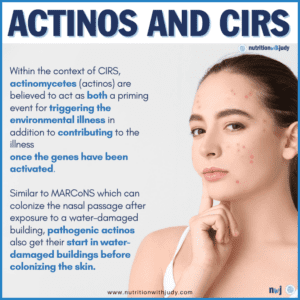

Within the context of CIRS, actinos are believed to act as both a priming event for triggering the environmental illness in addition to contributing to the illness once the genes have been activated. With Shoemaker’s Genomic Expression: Inflammation Explained (GENIE) gene expression testing, we can tease out gram-positive and gram-negative bacteria as both priming events and contributors to CIRS.
While Shoemaker’s proprietary GENIE testing remains under the Research Use Only (RUO) designation, with the GENIE testing, it’s believed that we can look at the specific differential gene activation with specific proteins compared to control GENIEs. Some GENIEs are ordered at the beginning of treatment if finances are abundant— otherwise, it’s ordered when people are at a roadblock in their CIRS treatment.
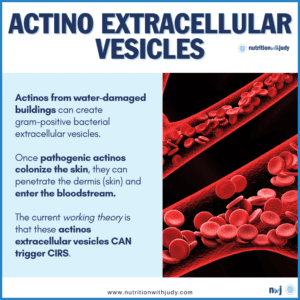

Similar to Multiple Antibiotic Resistant Coagulase Negative Staphylococci (MARCoNS), which can colonize the nasal passage after exposure to a water-damaged building, pathogenic actinos also get their start in water-damaged buildings before colonizing the skin. Actinos from water-damaged buildings are capable of creating gram-positive bacterial extracellular vesicles (EVs). It’s been recently discovered that these extracellular vesicles are derived from bacteria belonging to the gram-positive phyla actinobacteria and firmicutes.
This adds a new layer of complexity to understanding the bacterial physiology, host interactions, and pathogenesis. Once pathogenic actinos colonize the skin, they can penetrate the dermis with these extracellular vesicles and enter the bloodstream, triggering the genetic transcription production of inflammation represented on the GENIE by Map kinases and TGF-Beta receptors one, two, and three. The current working theory is that specifically, these actinos extracellular vesicles can trigger CIRS.
Testing for Actinos
There are currently three methods to test for actinos:
Testing for actinos is currently only available from EnviroBiomics.
Actinos Environmental Testing
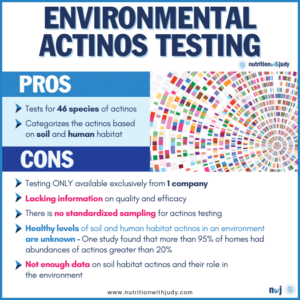

EnviroBiomics environmental actinos testing checks for 46 different actinos species. It groups these various actinos found in an indoor environment into two types: Soil habitat (SH) and human habitat (HH). Soil habitat actinos are naturally derived from sources outside and generally aren’t the cause of CIRS or symptoms in CIRS patients. Soil habitat actinos can enter the home from shoes, outdoor pets, and other outdoor sources.
Human habitat actinos are the ones problematic for CIRS patients as they generate toxins and activate the innate immune system, resulting in chronic inflammation. Shoemaker posits that much of the brain atrophy seen on NeuroQuant (NQ) testing is believed to result from human habitat actinos.
NeuroQuant is a brain imaging software used to identify areas of potential neurodegeneration— since CIRS is linked to structural brain changes, NeuroQuant may provide additional data for each patient’s treatment course. However, emerging research suggests that we cannot fully delineate (with p-value statistical significance) what the source of specific brain changes (swelling, atrophy) seen on the NeuroQuant is from.
On the EnviroBiomics report, you’ll see two indexes based on the ratio of soil habitat and human habitat actinos. These indexes are referred to as the Dominance Index (DI) and the Prevalence Index (PI). We originally learned from Shoemaker that there are correlations between Dominance Index and Prevalence Index on our initial actinos index testing report and GENIE results. The initial goal was to see 2.0 or less on the Dominance Index and Prevalence Index.
However, practitioners have seen, including in our clinical practice, that things often go in the wrong direction regarding the Dominance Index and Prevalence Index. This means with the current actino cleaning and hygiene recommendations–the EnviroBiomics test result numbers have been increasing–the numbers are moving in the wrong direction. Since soil habitat actinos can drop faster and tend to remain at lower concentrations while human habitat actinos reseed faster, the Dominance Index and Prevalence Index are no longer ideal ratios and shouldn’t be used to gauge the environment.
Shoemaker has now made recent statements that the Dominance Index and Prevalence Index aren’t as significant as the raw data. He recommends looking at these two main pathogenic species:
- Corynebacterium tuberculostearicum (C. tuberculostearicum)
- Propionibacterium acnes (P. acnes)
These two actino species are unique because they’re very waxy and contain immune-triggering mycolic acid in their cell wall layer. He recommends looking at numbers higher than 10,000 for all actinos species (on the EnviroBiomics test), particularly with these two pathogenic strains.
A rigorous and thorough cleaning protocol has been recommended as the solution to address the issue of apparently elevated actinos levels. We’ll examine the current cleaning recommendations later on in this article.
Concerns With Actinos Environmental Testing
- Currently, testing is exclusively offered by a single company. While there are two other reputable firms from which the Environmental Relative Moldiness Index (ERMI) and Health Effects Roster of Type-Specific Formors of Mycotoxins and Inflammagens – 2nd Version (HERTSMI-2) tests can be acquired, EnviroBiomics stands as the sole provider of actinos testing. This situation is far from optimal, as it precludes the possibility of comparing test results through an independent third party.
- Some practitioners have confidentially expressed concerns regarding the reliability of the testing results.
- We lack information on control studies conducted to determine the quality and efficacy of actinos environmental testing and results.
- There is no standardized sampling for actinos testing— Indoor Environmental Professionals (IEPs) and practitioners share different viewpoints for ideal collection methods.
- At the time of writing this article (March 2024), we do not know what healthy levels of either soil habitat or human habitat actinos are in any indoor environment.
- According to Larry Schwartz, a certified Shoemaker Indoor Environmental Professional, when he reviewed 60 actinos environmental home tests, all of them had actinos— more than 95% of those homes had abundances greater than 20%, further showcasing our limited data on what healthy levels are.
- We also do not have enough research on soil habitat actinos— most of Shoemaker and standard care research is on human habitat actinos.
Actinos Skin Testing
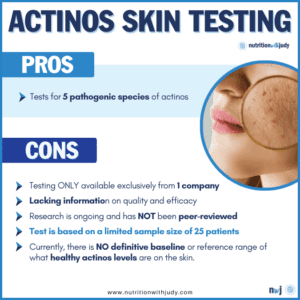

EnviroBiomics also offers an actinos skin test to see what level of human habitat actinos you are producing. The actinos skin test checks for the following five pathogenic species:
- Corynebacterium amycolatum
- Corynebacterium simulans
- Corynebacterium tuberculostearicum
- Corynebacterium xerosis
- Propionibacterium acnes
Shoemaker created a normal and healthy baseline of 10,000 or less for EnviroBiomics actinos skin test results. The five pathogenic actinos species are based on the 25 patients who were healthy controls. Based on the control testing, actinos skin test swabs should be (only) performed behind the ears for sampling. No other areas of the body were tested by the 25 patient controls.
However, recently there have been reports of individuals instructed to actinos skin test the feet, nasal passages, vaginal canals, male reproductive cells, and other areas of the body. One of these patients, showing seemingly elevated levels of actinos on his semen sample, was given a course of oral antibiotics (Zithromax, Z-Pak) followed by probiotics. The male patient had chronic spermicides and ejaculation pain. It has been reported that, following antibiotic treatment, the actinos in his sperm were eradicated. We are unclear if his symptoms have subsided.
While the n=1 is a great success story, the concern is that it is a n=1 share. But this case study share is now being used as a treatment for other individuals with assumed actino levels beyond the safe boundaries in vaginal swabs and other areas of the body. However, control testing for these areas is notably absent beyond the 25 patient control cases conducted behind the ear.
Additionally, to combat seemingly elevated skin actinos, the blanket hygiene protocol has been presented as part of the current solution. We’ll examine the hygiene protocol as well as the emerging use of antibiotics for self-produced actinos later in this article.
Concerns With Actinos Skin Testing
- As we mentioned above, all actinos testing is only available from one source. This situation is far from optimal, as it precludes the possibility of comparing test results through an independent third party.
- We lack information on control studies conducted to determine the quality and efficacy of actinos skin testing protocols and results.
- Some practitioners have confidentially expressed concerns regarding the reliability of the testing results.
- The actinos skin research is still ongoing— it hasn’t been published or peer-reviewed.
- Shoemaker’s limited sample size of 25 patients in the control group doesn’t provide enough data to definitively establish what healthy levels of actinos are.
- We currently do not have a definitive baseline or reference ranges of what healthy actinos levels are on the skin.
Actinos Plasma Testing
The last actinos test available is the plasma test. The actinos plasma test is for detecting the level of actinos in the blood. It could be potentially helpful for determining what level of actinos extracellular vesicles have made it to the bloodstream.
There are no established normal reference ranges on plasma either— the testing only shows the total number with no reference range.
With no established ranges, we don’t recommend this testing until more definitive, applicable data is available. We also have never had any of our patients test their actinos plasma levels so we can’t speak to any other potential benefits or data sets obtained by completing this testing at this time.
Concerns With Actinos Plasma Testing
- Similar concerns as the actinos skin testing— only available from EnviroBiomics, the actinos plasma research is still ongoing, and there are no established reference ranges.
The Shift From Fungus to Actinos
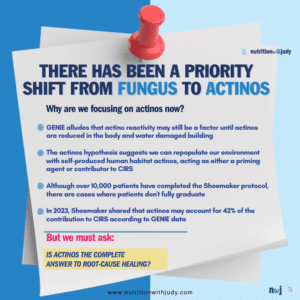

Cholestyramine (CSM) and Welchol, the two prescription binders used in the Shoemaker Protocol, have been documented to downregulate the transcription of TGF-Beta receptors one, two, and three which are believed to be activated by actinos extracellular vesicles. However, on the GENIE, map kinases can still be high until there’s an adequate reduction in actinos in the building and body.
The actinos hypothesis suggests that we can repopulate our environment with self-produced human habitat actinos, serving as a priming agent or a contributor to CIRS activation. These ideas initiate the conversation for continued research into actinos.
Although over ten thousand patients have completed the Shoemaker Protocol, there have been cases where patients experience roadblocks and cannot entirely graduate from the protocol, even in a cleanly remediated environment (with a low HERTSMI-2 score of 10 or below, which is deemed acceptable for those suffering with CIRS). In this continued search for answers, we must ask, ‘Is actinos really the complete answer to root-cause healing?’
Additionally, in late 2023, Shoemaker shared that actinos may account for 42% of the contribution to CIRS, endotoxins for 28%, beta-glucans for 23%, and mold surprisingly only for 7%. This is a considerable shift as actinos were originally hypothesized as a secondary concern to other biotoxins found in water-damaged buildings. The focus was to remove the fungal burden from the property so that any residual actinos could be mitigated through the post-remediation small particle clean as well as proper ongoing cleaning and maintenance. These findings are based on the collective results of GENIE— the proprietary gene expression testing that people generally only order when they’re at a roadblock with Shoemaker’s CIRS treatment.
While GENIE testing and subsequent actinos testing from EnviroBiomics demonstrates the potential significance of water-damaged buildings actinos as a priming agent in CIRS, we don’t have enough data to infer the implications to human health and ongoing environmental cleaning and maintenance.
Since actinos can proliferate and become a problem in water-damaged buildings in a way that they aren’t in buildings free of water damage, completing successful remediation under the Indoor Environmental Professional Panel of Surviving Mold Consensus Statement for Microbial Remediation guidelines should theoretically solve the root of this issue.
With so many questions remaining to be answered and the recognition of incomplete data sets, this is where the current actino cleaning and hygiene recommendations come into question.
We are grateful to Shoemaker and his research practitioners for their incredible work and continued research into this area. And while we do agree on many things, including how productive the Shoemaker Protocol can be for treating mold illness and supporting other biotoxin conditions such as Lyme, let’s take a closer look at the current Shoemaker actinos recommendations and if they make sense for our Nutrition with Judy CIRS community at this point in time.
Current Shoemaker Actinos Recommendations
Actinos are very hardy compounds, and the pathogenic species can form a biofilm around the colony that makes them resistant to killing attempts while helping them stick to surfaces. These components of their biology are another one of the reasons why the current actinos cleaning and hygiene recommendations are as meticulous as they are.
We all agree that actinos have always been an issue, but the cleaning and hygiene protocols may be of evidence-based concern. Before we examine some patient case studies, let’s discuss the pros and cons of these current recommendations.
Fantastik
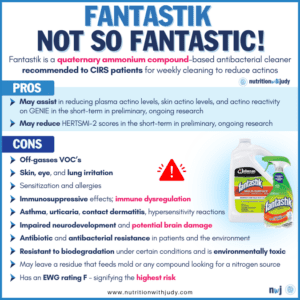

CIRS patients are currently instructed to use Fantastik as the primary cleaner for wet-wiping all surfaces within the home. Fantastik is recommended for both the initial actinos deep clean that addresses all horizontal and vertical surfaces as well as an ongoing weekly cleaning of horizontal surfaces in bedrooms and bathrooms.
While this recommendation is only for individuals who tolerate chemicals, most of our patients cannot tolerate them in practice. That’s because Fantastik has volatile organic compounds (VOCs) that can cause off-gassing— VOCs are known to be a common complication for CIRS patients as the toxicity from these gasses can add to the toxic burden.
Many individuals with CIRS become increasingly sensitive to VOCs over the course of the illness.
Why Is Fantastik Being Recommended for Actinos?
In a current study that has yet to be published or peer-reviewed, participants were asked to do the following:
Step One: Participants were instructed to HEPA vacuum the walls and ceilings once a week and their floors three times a week for two weeks. A baseline round of patient tests was taken at this step.
Step Two: Participants were then instructed to run Air Oasis IAdaptAir filters, moving them to different corners of the room every 12 hours for two weeks. This step alone resulted in a significant decrease in pathogenic skin actinos and an improvement in GENIE results after week two, particularly in proliferative physiology, mycotoxin reactivity, molecular hypometabolism, and actinos reactivity.
Step Three: Participants were then instructed to continue running IAdaptAir filters and using Fantastik spray once a week for four weeks in their bedrooms alone. Some individuals with small homes used Fantastik to clean their entire homes. After two weeks, the third round of lab reports showed a considerable improvement in plasma actinos and HERTSMI-2 scores.
Step Four: After week four of cleaning with Fantastik spray and running IAdaptAir filters, the participants’ fourth round of test results showed an even more considerable decrease in pathogenic skin actinos, HERTSMI-2 scores, endotoxin scores, and further improvements in actinos reactivity on GENIE results.
The total actinos scores on the dust samples through all four rounds of testing remained relatively the same despite improvements in plasma actinos, skin actinos, and actinos reactivity on GENIE.
Here are our preliminary questions and concerns based on the current data available from this incomplete study:
- Since there isn’t a control group in this study that shows what happens if participants only did the initial vacuuming and left the iAdaptAir units running, how do we know definitively that Fantastik spray is responsible for the lab results from steps three and four?
- It’s wonderful that improvements were observed in terms of plasma actinos, skin actinos, and actinos reactivity on GENIE results, but what about symptoms? Did symptoms improve? Did the participants experience any positive or adverse reactions?
- Most cleaning efforts using various other products and methods have been shown to reduce HERTSMI-2 scores so this isn’t as significantly important. Considering there are concerns that the active ingredient in Fantastik may feed mold, we would need follow-up data to see the long-term effects of this.
- How large is this study? How many participants partook? What was the difference in findings between the individuals who cleaned their bedrooms only with Fantastik vs. the individuals who cleaned their entire homes with Fantastik during step three?
- Will there be follow-up testing on all the labs taken in the long term to see if ongoing cleaning is warranted? Or are patients expected to clean like this indefinitely?
- With no established healthy actinos levels in the environment, skin, or plasma, how will we know when enough actinos levels have been reduced?
Our Concerns With Fantastik
It would be one thing if our patients could tolerate this synthetic commercial cleaning product or if it worked to reduce their symptom load. Unfortunately, that’s not what we’re seeing— individuals who diligently clean surfaces weekly with Fantastik spray aren’t moving the needle with this step alone, regardless of where they are in the protocol.
If Fantastik was relatively safe and benign in terms of toxicity, we wouldn’t hold the same concerns. However, here are some of the risks associated with quaternary ammonium compounds (QACs), the active ingredient in Fantastik:
- Skin and eye irritation: Quaternary ammonium compounds have the potential to induce skin irritation or contact dermatitis. They can also cause eye irritation.
- Sensitization and allergies: Quaternary ammonium compounds can play the role of sensitizers and irritants to the skin and mucous membranes, and promote the development of airway allergies.
- Lung irritation: Inhaled quaternary ammonium compounds in mice caused concentration-dependent decreases in tidal volume and pulmonary irritation.
- Immunosuppressive effects: One study reported that immune dysregulation has been linked to the use of quaternary ammonium compounds. It is believed that quaternary ammonium compound exposure may exacerbate autoimmunity associated with lupus.
- Hypersensitivity reactions: Another study has implicated that quaternary ammonium compounds may cause occupational asthma, urticaria, contact dermatitis, and other hypersensitivity reactions. Quaternary ammonium compounds may be responsible for neuromuscular blocking agents sensitization by cross-reactivity— this hypothesis is supported by the higher prevalence of QA-specific IgE in the professionally exposed populations.
- Potential brain damage: A recent study reported that quaternary ammonium compounds may impair neurodevelopment as these compounds are potently and selectively cytotoxic to developing oligodendrocytes. Oligodendrocytes are critical cells that play a role in the functioning of the central nervous system.
- Risk of antibacterial resistance: Quaternary ammonium compounds may contribute to antibiotic resistance in patients and the environment.
- Environmental toxicity: Even though quaternary ammonium compounds are considered to be aerobically biodegradable, their degradation is affected by their chemical structures. High levels of quaternary ammonium compounds have been detected in both sediment and sludge samples, showing their resistance to biodegradation under certain conditions. Quaternary ammonium compounds are toxic to many aquatic organisms— antibiotic resistance has emerged in microorganisms due to the excessive use of this cleaning compound.
- Residue risks: Some of the Shoemaker Indoor Environmental Professionals have raised concerns about the residue left behind by quaternary ammonium compounds. The residue may feed mold or anything looking for a nitrogen source. Professor George Bean was funded to look at different types of disinfectants with three mold species: Stachybotrys chartarum, Chaetomium globosum, and Aspergillus niger— all the quaternary ammonium compounds products increased the growth for all three organisms tested.
- EWG rating F: The Environmental Working Group (EWG) offers a comprehensive database with safety data on various ingredients used in household and personal care products. The EWG uses a rating system that ranges from a letter grading system, such as “A” to “F,” where “A” represents the lowest risk and “F” signifies the highest risk or concern. This letter grading system is more commonly seen in their Guide to Healthy Cleaning. Fantastik’s F rating indicates the highest level of health and environmental concerns associated with the ingredient. You can read more about the F rating here.
The risks associated with the immune system, developing hypersensitive reactions, antibacterial resistance in the environment, and antibiotic resistance in hosts are alarming, especially for CIRS patients with significant existing immune dysfunction.
Not only is the active ingredient in Fantastik problematic, but the inactive ingredients also pose the following risks:
- Diisopropanolamine (DIPA): Diisopropanolamine presents oral and dermal toxicity in rats. It can also act as a skin irritant and contact sensitizer.
- Isotridecanol: According to the European Chemical Agency (ECHA), isotridecanol can cause skin irritation as well as serious eye irritation and damage.
- Fragrance: There are nine ingredients total that constitute the fragrance component of Fantastik. From allergies and contact dermatitis to endocrine-disrupting properties, there are countless concerns with any synthetic fragrance.
Windex
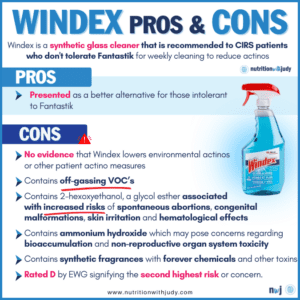

Windex is another commercial cleaning product that’s recommended as an alternative to Fantastik for the actinos cleaning protocol.
While it seems to be slightly more tolerable by a few of our patients, most still don’t tolerate this product due to its VOCs.
Why Is Windex Being Recommended for Actinos?
We discovered that many CIRS practitioners recommend Windex for those unable to tolerate Fantastik. There are no current ongoing studies and research regarding the efficacy of Windex for reducing actinos.
Our Concerns With Windex
Windex includes chemical disinfectants and synthetic cleaning agents that are associated with the following risks.
It’s important to note that while we generally don’t recommend using Windex as a cleaning product, the sporadic use of Windex for monthly window cleaning might not significantly impact health. However, the concerns intensify with the actinos cleaning protocol’s recommended frequency of use:
- 2-Hexoxyethanol: 2-hexoxyethanol is a type of glycol esther associated with occupational risks of increased spontaneous abortions in women, congenital malformations with pregnancy exposure, as well as localized and systemic toxicity including skin sensitization and irritation, reproductive, developmental, and hematological effects.
- Ammonium hydroxide: Chemically structured similarly to quaternary ammonium compounds, ammonium hydroxide may pose concerns regarding bioaccumulation, non-reproductive organ system toxicity, and more.
- Fragrance: Windex contains 10 ingredients that are classified as fragrance components. From skin allergens to VOCs that impact indoor air quality, there are always concerns associated with any product that contains fragrance.
- EWG rating D: EWG has rated Windex with a D, you can learn more here.
Surviving Mold Consensus Plus Vinegar Cleaning Solution
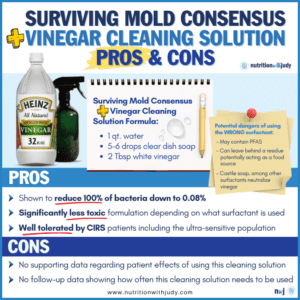

Larry Schwartz, one of the Shoemaker-approved Indoor Environmental Professionals, released a white paper called Sources of Actinomycetes Environmental Bacteria In Homes and Methods of Controlling Their Proliferation and Levels. The paper discusses how we should clean our homes and where the highest concentration of actinos are found.
Why Is This Cleaning Solution Recommended for Actinos?
In Schwartz’s paper, four different cleaning agents were used to determine their impact on environmental actinos. Environmental testing was completed prior to and after each cleaning agent. This paper was completed before the ongoing Fantastik study— Fantastik was not a part of this data set.
The two top-performing cleaning agents were the Surviving Mold Consensus Cleaning Solution and the Surviving Mold Consensus Plus Vinegar Cleaning Solution. Here are the formulas for both:
- Surviving Mold Consensus Cleaning Solution: 1 qt. water and 5-6 drops of clear dish soap
- Surviving Mold Consensus Plus Vinegar Cleaning Solution (SM+V Cleaning Solution): 1 qt. water, 5-6 drops of clear dish soap, and 2 tablespoons of distilled white vinegar
The pH of the SM+V Cleaning Solution was between 3.5 and 4.0. The solution of only dish soap and water reduced 100% of bacteria down to 0.12%. The addition of white vinegar brought it down to 0.08%. Both are excellent results— however, an improvement is observed by lowering the Surviving Mold Consensus Cleaning Solution’s pH with the addition of vinegar.
One of the interesting findings from this paper was that the EC3 Mold Solution caused the gram-positive bacteria to increase post-cleaning. The third cleaning solution used was an undisclosed commercial cleaner that showed some reduction in actinos but was not nearly as effective as the two solutions listed above.
The Nuance Behind Larry Schwartz’s Findings
The SM+V Cleaning Solution is recommended as an alternative for patients who don’t tolerate Fantastik and Windex— many of our patients use this cleaning solution for that very reason.
While this small experiment showed significant environmental actinos reduction, the data is very limited that we aren’t able to draw any additional conclusions for the following concerns:
- This paper only looks at the environmental aspect— we don’t have any data showing the effects of this cleaning solution for the patient directly like the Fantastik actinos study outlined above.
- There needs to be follow-up data showing how often this cleaning needs to be completed before the actinos repopulate. Given the uncertainty around what constitutes healthy actino levels—which may vary individually—the question of an appropriate cleaning schedule remains.
- While the small amount of 5-6 drops of soap in his formula is minimal, synthetic surfactants still contain many toxic compounds, including per- and poly-fluoroalkyl substances (PFAS). PFAS are linked to adverse health risks and are known as forever chemicals as they are nearly indestructible and resist degradation. PFAS will continue to build up in both the environment and our bodies.
- If the wrong surfactant is used in this formula, it can leave behind a residue that could act as a food source for bacteria and mold. Certain surfactants, including castile soap, lye-based soap, and many synthetic surfactants, also aren’t compatible with vinegar— only particular biosurfactants (plant-based surfactants) aren’t neutralized when combined with vinegar.
Cleaning Frequency and Methodology
To add more confusion to the topic, the cleaning frequency and methodology recommendations for the actinos protocol tend to differ among Indoor Environmental Professionals and CIRS practitioners.
Some Indoor Environmental Professionals are generally against wet wiping the walls. In contrast, others say dunking a microfiber cloth into your preferred cleaning solution is more effective than applying it with a spray bottle. Several Indoor Environmental Professionals recommend reducing vacuuming to avoid agitating the air within homes. Instead, they suggest that wet wiping, utilizing lint rollers as an alternative, and increasing the frequency of laundering are more effective strategies.
Many of our patients have reported back to us that their CIRS practitioners request additional cleaning efforts if their CIRS markers or symptoms aren’t improving or if they’re at any roadblock in the CIRS treatment.
Medicasp
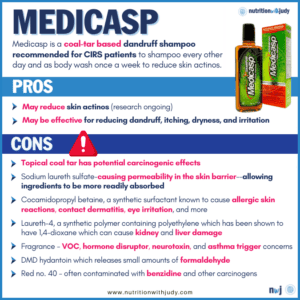

The second piece of the ongoing actinos protocol is for hygiene. Since pathogenic actinos can colonize the skin from a water-damaged building, this can cause individuals to produce excessive human habitat actinos. Shoemaker brought forth the first hygiene recommendation.
Medicasp is a dandruff shampoo that’s recommended for CIRS patients to shampoo every other day. It is also used as a body wash once a week. The frequency of Medicasp’s recommendations has changed multiple times, so this is one of the most recent recommendations. Most patients don’t tolerate this product either due to its synthetic fragrance and VOCs.
Why Is Medicasp Recommended for Actinos?
Medicasp’s active ingredient is coal tar. Coal tar is a by-product of carbonized coal and is commonly used in personal care products for itching, dryness, and irritation caused by psoriasis, eczema, dandruff, and other skin conditions. It has antibacterial properties that are believed to help slow actinos growth.
For patients who tolerate Medicasp, the current trend appears that it may reduce the amount of self-produced human habitat actinos only if they have remediated and are in a clean environment— otherwise, there have been cases of individuals’ actinos production increasing with use while still in exposure.
Our Concerns With Medicasp
Medicasp has many toxic ingredients that should be considered. While it may show some efficacy in preliminary research for reducing our self-produced human habitat actinos, here’s why we believe that we should be much more hesitant before recommending this product to CIRS patients:
- Coal tar: Research shows that coal tar may effectively treat dermatitis, eczema, psoriasis, and other skin conditions, but it is the subject of studies concerning various carcinogenic and immune system effects. There’s conflicting literature regarding the topical use of coal tar and its potential carcinogenic effects— additionally, coal tar exposure may increase the risk of lung, scrotum, and skin cancer. One study found that topical application can cause potentially carcinogenic DNA changes in human tissue.
- Sodium laureth sulfate (SLS): The synthetic surfactant is often manufactured from petroleum. It makes the skin more permeable by stripping sebum (an oily, waxy substance produced by your body’s sebaceous glands that coats, moisturizes, and protects your skin), allowing all of the ingredients in this formula, including sodium laureth sulfate, to be more easily absorbed. Sodium laureth sulfate can cause severe skin irritation and has a higher rate of contact allergies. The World Health Organization (WHO) has several health warnings about sodium laureth sulfate. It’s also a known pollutant, and has been suggested that chronic toxicity of sodium laureth sulfate can also occur at low concentrations.
- Cocamidopropyl betaine (CAPB): Cocamidopropyl betaine is another synthetic surfactant named by the American Contact Dermatitis Society as “Allergen of the Year” in 2004. It can cause allergic skin reactions, contact dermatitis, eye irritation, and other dermatological side effects.
- Laureth-4: This is a synthetic polymer composed of lauryl alcohol and polyethylene glycol (PEG). Due to the presence of PEG, this ingredient may contain toxic manufacturing impurities such as 1,4-dioxane. 1,4-dioxane can cause kidney and liver damage and is believed to be a carcinogen and irritant that quickly penetrates the skin.
- Fragrance: There are many health risks and symptoms associated with artificial fragrance, including VOC concerns— it’s classified as allergens, hormone disruptors, asthma triggers, neurotoxins, and carcinogens. Fragrances also commonly contain phthalates, which are endocrine disruptors and also associated with cancer, human reproductive and developmental toxicity, endocrine disruption, birth defects, respiratory problems, genital malformations and undescended testes in baby boys, and lower sperm counts in men. These chemicals applied topically can pass from the skin into the bloodstream.
- Polysorbate-20: This nonionic surfactant also contains polyethylene glycol so it may contain toxic manufacturing impurities such as 1,4-dioxane.
- DMD hydantoin: DMD hydantoin releases small amounts of formaldehyde, a chemical which, according to the Department of Health and Human Services (HHS), has links to cancer. A 2015 report also connected formaldehyde to allergic skin reactions.
- FD&C red no. 40: While ingesting red no. 40 is associated with many adverse health risks including hyperactivity in children as well as depression and suicidal thoughts, and it may pose different risks topically. This dye is contaminated with benzidine and other carcinogens.
Defense Soap
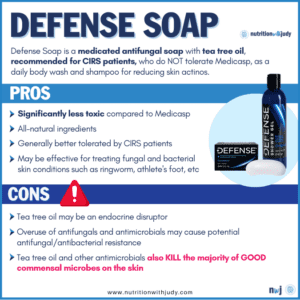

Defense Soap is a newer recommendation for the actinos hygiene protocol as many people weren’t tolerating the Medicasp. The medicated antifungal soap was developed for athletes to treat ringworm, athlete’s foot, jock itch, and other fungal conditions.
While the Defense Soap ingredients are much cleaner when compared to Medicasp, some of our patients have reported staph skin infections, rashes, skin irritation, and excessively dry skin after use.
Why Is Defense Soap Recommended for Actinos?
Dr. Dorninger, a Shoemaker-certified practitioner, is currently conducting an ongoing study regarding the efficacy of Defense Soap in reducing human habitat actinos on the skin. In his preliminary research, Defense Soap reduces the amount of human habitat actinos on skin tests.
However, there is a portion of patients where none of the actinos hygiene recommendations are working, and they actually see an increase in self-produced actinos after using these products.
Tea tree oil is the active ingredient in Defense Soap and is known to contain antibacterial and antifungal properties. Tea tree oil is used in this application to help slow actinos growth.
Our Concerns With Defense Soap
Some of our patients are experiencing adverse effects with this product. Research also suggests that tea tree oil is an endocrine disruptor. EWG rates tea tree oil as a 6 out of 10 (10 being the worst in terms of toxicity). Since tea tree oil in itself may be problematic, we’re theorizing that sensitive individuals could be affected by the following:
- Potential antifungal resistance: The overuse of antifungal agents can contribute to developing antifungal resistance, making it imperative to use these agents judiciously and explore differing strategies to manage and prevent resistance.
- Potential antibacterial resistance: Natural antimicrobials can also contribute to antibacterial resistance. Bacteria have developed various resistance mechanisms to cationic antimicrobial peptides (CAMPs), naturally occurring antimicrobial agents. These mechanisms include reducing the antimicrobial’s access to target sites, modifying the antimicrobial target, and directly inactivating the antimicrobial compounds. One study found habituation to sub-lethal concentrations of tea tree oil is associated with reduced susceptibility to antibiotics in human pathogens, indicating a potential risk for resistance development when tea tree oil is not used properly.
- Kills the majority of good skin microbes: Even though tea tree is natural, it kills any pathogenic microbes on the skin’s surface and the majority of commensal or good microbes.
Castile Soap
Castile soap is the alternative recommendation for patients who don’t tolerate Medicasp and Defense Soap. In Dr. Doringer’s ongoing study, his preliminary research shows castile soap also effectively reduces actinos.
Our patients generally tolerate this soap, although some find it drying. The natural formulation of castile soap has a much lower risk of causing side effects. Castile soap preliminarily has also been reported to reduce actinos on the skin.
Hygiene Frequency
CIRS patients are instructed to shower daily regardless of their cleanliness level. While we understand the concern of reseeding the environment with our self-produced human habitat actinos, overwashing the skin leads to problems with the skin microbiome. Over-cleansing or over-sanitizing can increase the risk of infection from opportunistic pathogens.
Patient Case Studies Using the Current Actino Protocols
We’re presenting two case studies representative of what our practice is seeing in our patients who have been diligently following the actino protocols.
Case Study One – Patient One | 32-Year-Old Female
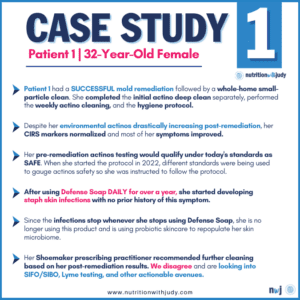

Background
A 32-year-old female patient did the initial actinos deep clean four months before remediating her home. She continued with the weekly cleaning up until the remediation. A whole-home small particle clean was completed using Aerosolver after her remediation passed post-clearance testing. She had hired weekly help to consistently keep up with the weekly actinos cleaning post-remediation. For the weekly actinos cleaning, she used the SM+V Cleaning Solution with Branch Basics. She and her husband used the Defense Soap daily for body wash and shampoo, as Medicasp was not tolerated.
Baseline Testing Results and Symptomology
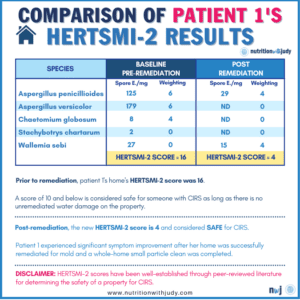

- Mold Testing: Prior to remediation, the HERTSMI-2 score was 16. A score of 10 and below is considered safe for someone with CIRS as long as there is no unremediated water damage on the property.
- Actinos Testing: The actinos testing Dominance Index was 0.5 and the Prevalence Index was 3.1. Before the recent shift to disregard the Dominance Index and Prevalence Index, it was believed that any testing within 2.0 for both indexes was considered safe for CIRS patients. That’s why this patient was instructed to complete the full actinos protocol— something to consider is that if she had started the Shoemaker Protocol more recently, her home would’ve already been considered safe for actinos under current recommendations based on the level of pathogenic species listed below.
- Environment Pathogenic Actinos Species Testing: The pathogenic species of C. tuberculostearicum was 4,912 and P. acnes was 5,458. Based on Shoemaker’s current theory that pathogenic species must be within 10,000 or below, these results would be considered safe for CIRS.
- Patient Actino Skin Testing: The patient’s actino skin testing only showed one strain above Shoemaker’s current theorized healthy baseline of 10,000— her P. acnes result was 12,271. Her husband’s actino skin testing also only showed one seemingly elevated strain; his P. acnes result was 82,508. Her husband does not have CIRS or any other health conditions or symptoms.
- Patient Symptomatology: While the patient experienced progress with symptom improvement by using the prescription binder Cholestyramine while still in exposure, she struggled with poor sleep, headaches, trouble concentrating, brain fog, frequent urination, low sex drive, anxious episodes, gut issues, and histamine intolerance.
Post-Remediation Results
The patient was not able to complete her post-remediation testing until four months after the remediation as she was hospitalized for a separate condition. The actinos cleaning was still completed weekly by hired help until this testing was completed.
- Mold Testing: The new HERTSMI-2 score was 4 and well within the range of what’s considered safe for CIRS.
- Actinos Testing: The new actinos testing Dominance Index was 1.2 and the Prevalence Index was 1,347.5.
- Pathogenic Actinos Species Testing: The new C. tuberculostearicum increased by almost 2,415% at 123,515 and the new P. acnes increased almost 3,314% at 186,331. These results are well over the current theorized threshold of 10,000.
- Patient Actino Skin Testing: The patient never received any follow-up instructions regarding further skin testing from her Shoemaker prescribing practitioner. They were instructed to use Defense Soap indefinitely “just in case.” Since both she and her husband were diligent with both the actinos cleaning and hygiene protocols, they did not prioritize the expense for another round of skin testing.
- Patient Symptomatology: The patient experienced significant symptom improvement post-remediation. All of the symptoms from above had resolved except for her histamine intolerance and gut issues that only occurred if she strayed from her current diet and supplement protocol. Despite environmental actinos increasing by thousands of percent, the patient’s symptoms improved.
Additional Patient Notes
At the time of this post-remediation environmental testing, the patient also had her CIRS markers retested. All of her markers were normalized and in range. She no longer had CIRS-specific symptoms but still had ongoing issues from small intestinal bacterial overgrowth (SIBO) and small intestinal fungal overgrowth (SIFO). Since her original actinos testing was in the proposed normal range for the pathogenic species, she had been consistent with the cleaning and hygiene protocol, and her CIRS markers were normalized to non-CIRS levels, she did not prioritize retesting and believes the newest result could be from sampling error.
This patient has developed staph skin infections after using Defense Soap long term— while we can’t directly confirm the correlation, she did not have these symptoms prior in her life. When she temporarily stopped using the Defense Soap after receiving her post-remediation results, the staph infections stopped and only came back when she resumed use. She has now stopped using Defense Soap altogether and is using probiotic skincare along with MegaSporeBiotic applied topically to repopulate her skin microbiome. She may consider incorporating castile soap for actino reduction in the future but is focused on supporting her skin health in the meantime.
She has also lowered the frequency of cleaning within her home as her symptoms do not change when comparing weekly cleanings to cleaning every two or three weeks.
Future Planning
Since she still has a couple of stubborn symptoms related to the gut and histamine intolerance, we are pursuing other clinical routes such as SIBO and SIFO treatment and Lyme testing. Rather than hyper-focusing on actinos with further cleaning, which was recommended to her by a Shoemaker prescribing practitioner, we believe there can be other missing pieces at play.
If she’s already doing the weekly cleanings after a successful remediation, small particle clean, and initial actinos deep clean— should the next logical step be doing another initial actinos deep clean or increasing cleaning to twice a week? We don’t think so. Co-infections and comorbidities are quite common with CIRS, so treating each patient holistically is critical for root-cause healing.
Case Study Two – Patient Two | 48-Year-Old Male
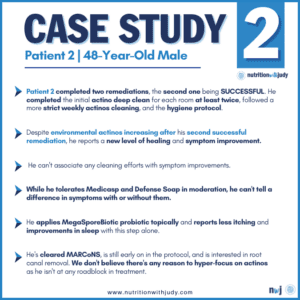

Background
After his first remediation, the 48-year-old male patient did the initial actinos deep clean. He completed this process over time and completed the full deep clean at least twice for each room. He has been consistent with the weekly cleaning and hygiene protocol for three months, including higher frequencies in terms of washing his bedding every two to three days and vacuuming his floors every three days. He uses a suite of cleaning products, including a thymol-based surfactant solution, Branch Basics, Fantastik, Windex, and vinegar. He does tolerate using Medicasp and Defense Soap in moderation.
Baseline Testing Results
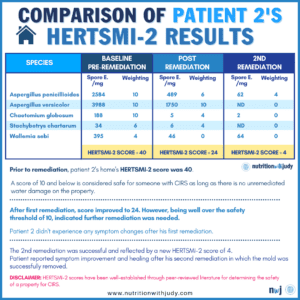
- Mold Testing: Prior to his first remediation, the HERTSMI-2 score was 40. After his first remediation in July 2023, the HERTSMI-2 score lowered to 24. The new score indicated further remediation was necessary as the threshold for CIRS safety is a score of 10 or below.
- Actinos Testing: The actinos testing completed after the first remediation had a Dominance Index of 2.2 and a Prevalence Index of 1,667.7.
- Pathogenic Actinos Species Testing: The pathogenic species of C. tuberculostearicum was 462,044 and P. acnes was 46,570. Both numbers are well above Shoemaker’s current theorized recommendation of 10,000 for each species.
- Patient Actinos Skin Testing: The patient’s actinos skin testing only showed one strain above Shoemaker’s current theorized healthy baseline of 10,000— his P. acnes result was 43,576.
- Patient Symptomatology: He struggles with sleep and itchiness, and experiences sinus issues, gum inflammation, gut discomfort, bloat, and brain fog, particularly after an exposure. The patient reported no symptom improvements after his first remediation.
Post-Remediation Results
The patient completed a second successful remediation in November 2023. For post-remediation testing, he utilized traditional testing measures from EnviroBiomics in tandem with AirAnswers, a portable device that captures and measures airborne pathogens.
- Mold Testing: The new HERTSMI-2 score was 4, reflecting a successful remediation and safe environment for CIRS.
- Actino Testing: The new actinos testing Dominance Index was 3.9 and Prevalence Index was 289.0. While the Prevalence Index improved, we’re now being told that these relative indexes no longer help determine the safety of a property.
- Pathogenic Actinos Species Testing: The new C. tuberculostearicum reflected a 124% increase from 462,044 to 1,035,258 and the P. acnes reflected a 2,180% increase from 46,570 to 1,061,882.
- Patient Actino Skin Testing: The patient has not completed any follow-up skin testing but is considering doing two samples behind the ear and his feet.
- Patient Symptomatology: The patient reports an improved level of healing once his home was successfully remediated from mold. He’s experiencing better sleep and fewer gum issues. He also reports that showering frequency doesn’t impact his symptoms either post-remediation. He still experiences itching but theorizes it’s from certain clothing or exposure to unfiltered water and certain foods. Despite environmental actinos increasing, his symptoms are overall improving.
Future Planning
The patient has cleared MARCoNS and is still working through the protocol. While he awaits the retest of his CIRS markers after his successful remediation, he will continue his more relaxed cleaning protocol as his symptoms remain similar to this frequency. He is also going to look into root canal removal for further healing.
He was told by a Shoemaker prescribing practitioner that the high actinos in his home will make him very sick. Based on this, he is determined to find out if actinos are an issue for him and how to resolve the seemingly elevated actinos in his home.
Since he is still early on in treatment and isn’t at a roadblock, we don’t believe there is any reason to hyper-focus on actinos considering the gaps in current data.
The NwJ Stance On the Current Actinos Recommendations
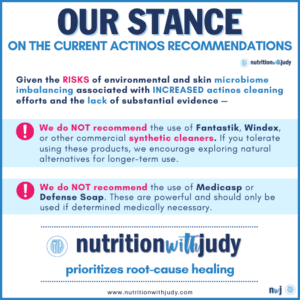

We follow the established Shoemaker CIRS protocol because it’s the only peer-reviewed, clinically replicable treatment protocol for CIRS. However, the current actinos protocol isn’t rooted in definitive data, and all the research is still ongoing and incomplete. Until more conclusive data showing the direct efficacy of these actinos recommendations in reducing symptoms and improving CIRS outcomes is established, we disagree with implementing this cleaning and hygiene approach.
If the existing data being utilized to define healthy baseline levels for actinos in skin and plasma remains incomplete, with notably small control group sizes, it implies that we are all participants in this ongoing experiment, potentially influenced by a range of variables. There is also a lack of established data on what constitutes healthy levels of actinos within the environment, which will likely vary from person to person.
In our practice’s pursuit of root-cause healing and definitive answers for our patients, we adhere to the principle of ‘do no harm.’ Given the risks associated with increased actinos cleaning efforts—particularly when such efforts could lead to environmental and skin microbiome imbalances—the current lack of substantial evidence raises concerns.
It’s problematic that patients are advised to fine-tune actinos cleaning based on insufficient data, especially when there are no evidence-based signs of improvement. The actinos cleaning approach may not serve the best interests of our patients seeking progress.
Even though calculated risks are sometimes necessary in practice, without enough justification, proceeding with recommendations that carry potential risks seems contrary to our commitment to patient safety, well-being, and overall immune regulation. (TLDR: This doesn’t seem like root-cause healing.)
What the cleaning seems to encourage instead is further nervous system dysregulation and fear of unseen microorganisms instead of pursuing other viable established routes (e.g., Lyme, MCAS, trauma).
We’ve seen more harm than good from the actinos protocol. The only patients who have benefited at our practice from the actinos cleaning protocol are individuals who did not remediate. This could very well be due to the mold burden removal and overall cleaning efforts, and can’t be definitively tied to actino removal. And the only patients we’ve seen benefit from the actino hygiene protocol are individuals with acne concerns— some individuals have reported their acne clearing after using Defense Soap short-term. We don’t know the implications of using this long-term and are hesitant due to the symptoms others are seemingly experiencing.
We disagree with the use of Fantastik, Windex, and other commercial synthetic cleaners. They do much more harm, have significant risks to various bodily systems, contain forever chemicals and other toxins, and can leave behind a residue after cleaning that may cause more downstream ill effects. The health risks and toxin burden of these products do not outweigh the net positive for these applications, especially considering the study utilizing Fantastik is still ongoing and limited.
We also disagree with using Medicasp and Defense Soap at this time. If we don’t know what healthy baselines are, we aren’t able to complete any follow-up testing to prevent the overuse of these products. These contain powerful antibacterial and antifungal agents and should only be used if medically necessary.
Environmental Considerations
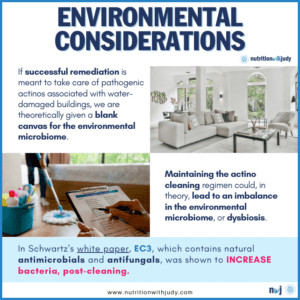

If successful remediation is supposed to take care of pathogenic actinos associated with water-damaged buildings, we are theoretically given a blank canvas for the environmental microbiome. Maintaining the actino cleaning regimen could, in theory, lead to an imbalance in the environmental microbiome, or dysbiosis. We are yet to understand the long-term effects of selectively targeting a single component within the complex ecosystem of the environmental microbiome.
In Schwartz’s white paper, EC3, which contains natural antimicrobials and antifungals, was shown to increase bacteria post-cleaning, and we are also seeing this happen in our practice. When bacteria are eliminated through sanitization, remnants or particles of the bacteria may continue to persist. These particles include the bacterial cell wall, DNA fragments, and other cellular components.
The bacterial remnants and their outcomes, including their potential to remain dormant and subsequently reactivate under the right conditions, are determined by various factors. These factors encompass the bacterial species, the conditions of their environment, and the sanitization method used to eliminate them.
Bacteria have developed survival strategies to withstand unfavorable conditions, including entering a dormant state. Dormant cells can survive conditions not conducive to growth and can re-initiate growth when conditions improve. This phenomenon is seen in various microorganisms, including spore-forming and non-spore-forming bacteria cells.
Similar to the importance of the Shoemaker method of removing mold versus simply killing it, perhaps we need to focus more on the physical removal of actinos instead of using killing and sanitization methods.
Hygiene Considerations
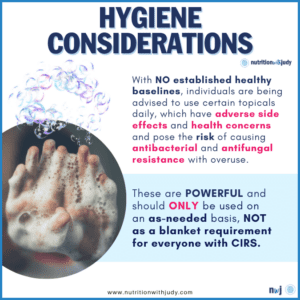

While preliminary research is showing potential efficacy with skin actinos reduction with Medicasp and Defense Soap, these products may come at a significant cost.
With no established healthy baselines, we’re now having individuals use these topicals daily, which have adverse side effects and health concerns and pose the risk of causing antibacterial and antifungal resistance with overuse. These are powerful and should only be used on an as-needed basis, not as a blanket requirement for everyone with CIRS.
Strengthening the Body (Host)
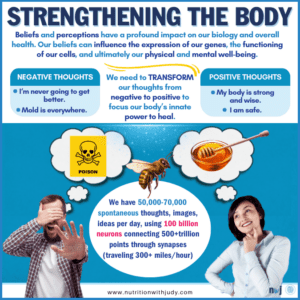

Much of our concern around these recommendations is that they go against strengthening our patients’ immune systems. All synthetic and commercial products recommended may weaken certain susceptible individuals over time, particularly in this already immune-dysregulated population.
Especially with the recent introduction of antibiotics for treating elevated skin actinos in various parts of the body, there is a large body of research establishing the consequences of antibiotic use. One major known risk is the imbalance of the body’s natural flora; by reducing bacterial populations with antibiotics, there’s an increased risk of fungal overgrowth as the competition is diminished. (And isn’t this the population we should be concerned with having a higher susceptibility to fungal overgrowth?)
The goal is never to sterilize the environment and rid it of all pathogens— it’s about finding a safe balance while healing our patients so they can build long-term resiliency to these environmental toxins. If we’re getting hyper-focused on actinos, what if we’re missing more significant, actionable pieces?
We work with the sickest of the sick and understand the support they often need by the time they start their CIRS journey. We owe it to our community to be mindful of their experiences and not overwhelm them with incomplete research that may be doing more harm than good.
We appreciate all the ongoing research efforts targeting actinos and know the Shoemaker community is looking for answers just as much as we are. We disagree with implementing these actinos protocols at this preliminary stage.
The NwJ Actinos Cleaning and Hygiene Protocol
We spent the time and resources digging into this topic in-depth and wanted to share this research with our CIRS community. We are dedicated to providing as many free resources as possible, but until we have more confident clinical results with our updated holistic health cleaning and hygiene protocols, we will only be sharing specifics of our new actinos cleaning and hygiene protocol in our CIRS Support Group or working with us one-on-one.
We commit to publicly sharing our protocol once we build more confidence with patient test results (environmental and bloodwork) and symptom relief. Stay tuned.
You can find our updated actinos cleaning and hygiene protocol (with disclaimers) alongside comprehensive, actionable insights for mold prevention and endotoxin management available for free here.
Closing Thoughts
It’s crucial to acknowledge the inherent risks involved with any protocol or dietary recommendation. As practitioners, our responsibility extends beyond mere treatment— it consists of investigating a patient’s medical history, a clinical assessment, and a comprehensive background history by posing the right questions at the right time. It’s about aligning lab results and environmental testing with the patient’s narrative. It’s a little bit of art, science, psychology, but most of all, building a relationship of trust.
Echoing the wisdom of Sir William Osler, a pioneering physician and one of the four founding professors at Johns Hopkins Hospital, “The good physician treats the disease; the great physician treats the patient who has the disease.” Our aim isn’t merely to eliminate CIRS from our chronically ill patients but to guide CIRS sufferers toward root-cause healing by achieving minimal symptoms.
At Nutrition with Judy, our commitment is unwavering in supporting our community to find root-cause healing, and this commitment aligns with our core values and mission statement. When something doesn’t seem right (or what I like to call passing the logic test), our practitioners must voice the logical truth or our evidence-based holistic health point of view. Regarding the actinos cleaning protocol, we only know with certainty that we don’t know what we don’t know.
While our practice never claims to have all the answers, we commit to seek them relentlessly, leaving no stone unturned in our quest to serve the chronically ill community. We truly believe and advocate that everyone should have the right to live a life nearly symptom-free. And while speaking truths or what some may call disrupting, we are ready if it saves one more starfish.
Work With Our Trusted CIRS Practitioners
The Nutrition with Judy practice is honored to be a trusted CIRS practitioner support serving clients from around the globe. We’re passionate about helping our clients achieve root-cause healing in order to lead the best quality of life possible that’s nearly symptom-free. Our team is dedicated to finding the answers our patients need. We welcome you to explore our free resources and are always available to support you through personalized protocols. If you’re interested in working one-on-one with our CIRS nutritional therapy team to support you through your journey, our CIRS Support Package delivers the support and accountability for achieving root-cause healing.
Start your root-cause healing journey today and contact us any time with any questions or concerns.
DISCLAIMER: This content is for educational purposes only. While we are board-certified in holistic nutrition and are nutritional therapy practitioners, we are not providing medical advice. Whenever you start a new diet or protocol, always consult with your trusted practitioner first.


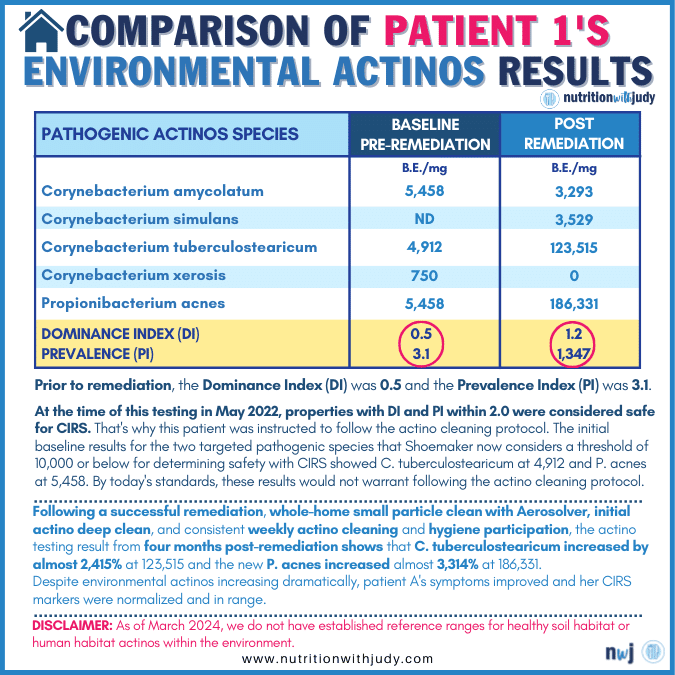
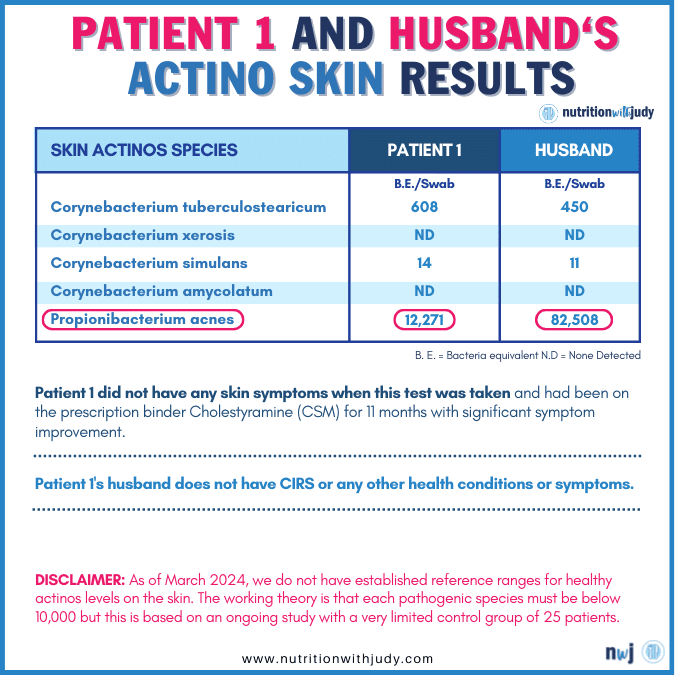
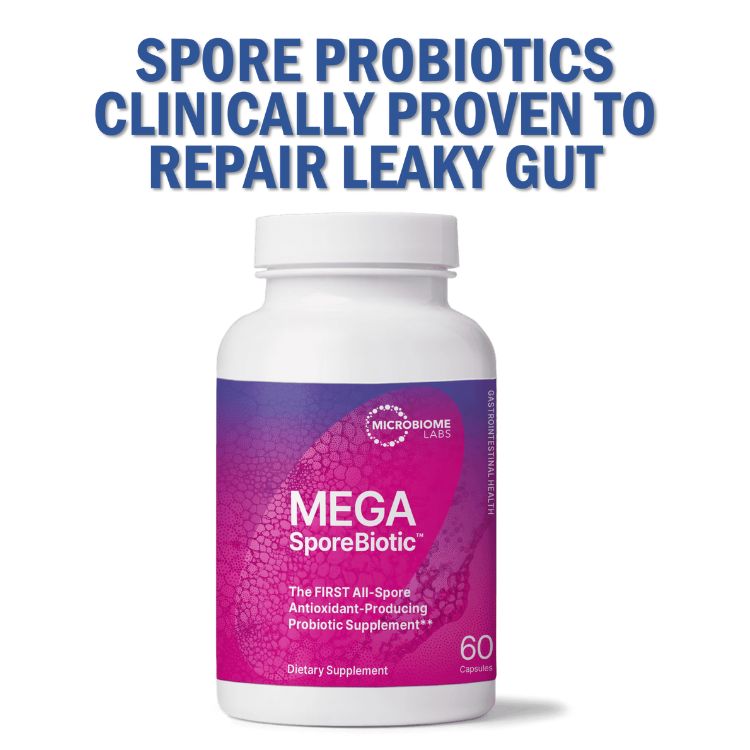
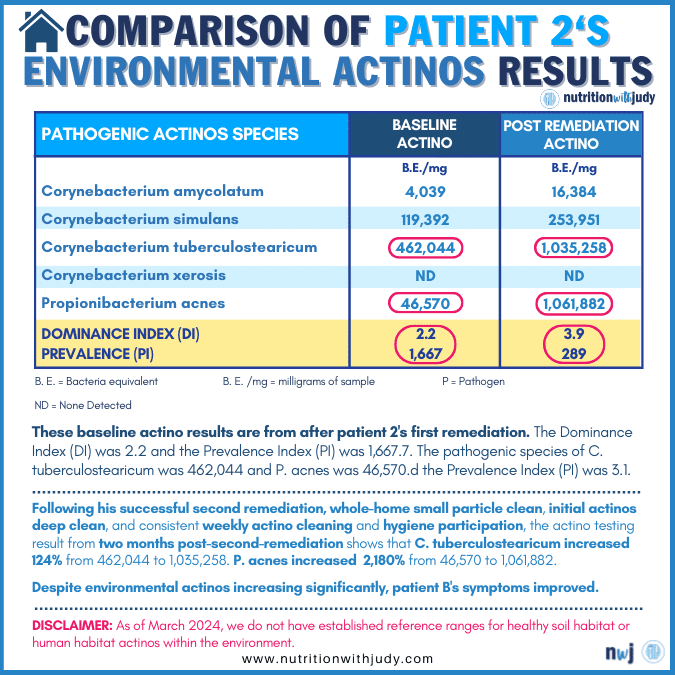
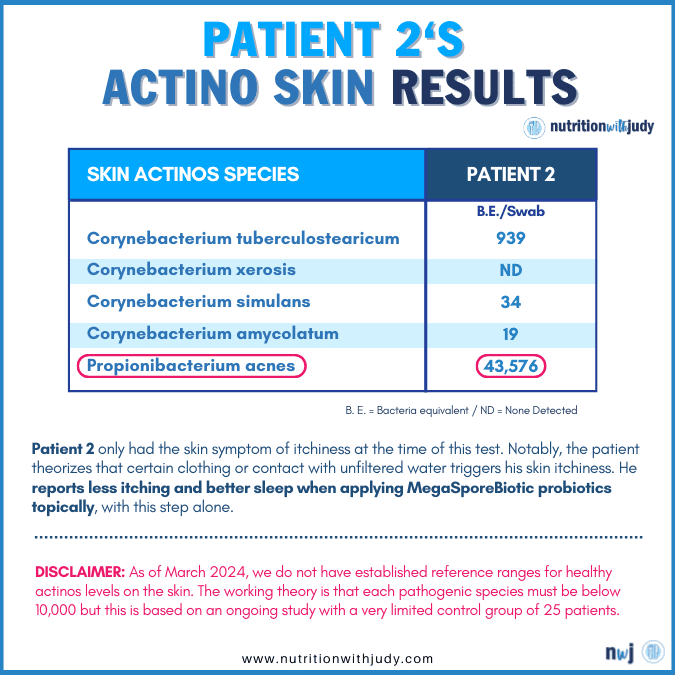
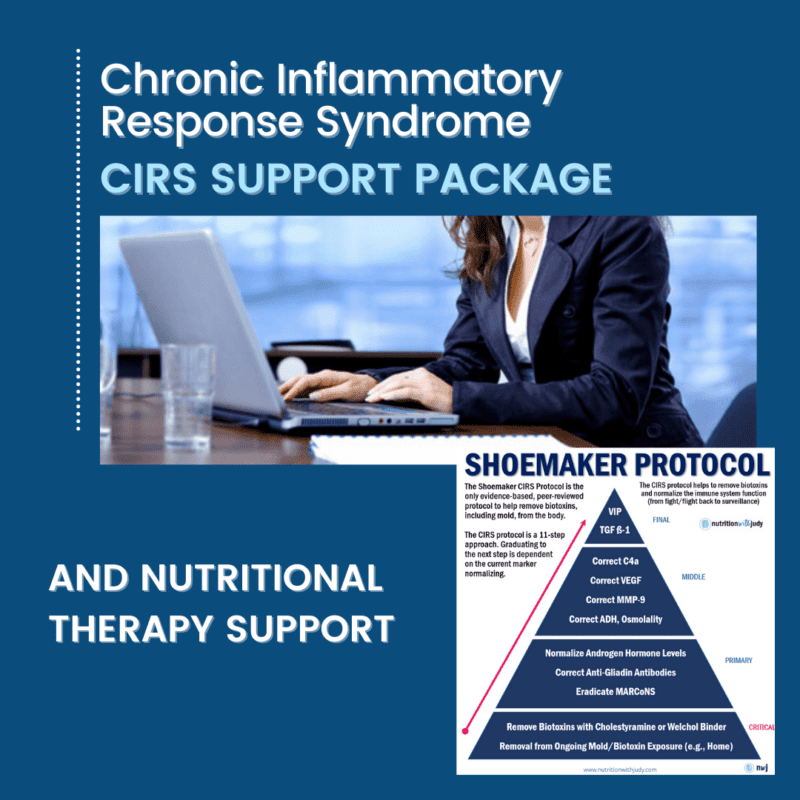
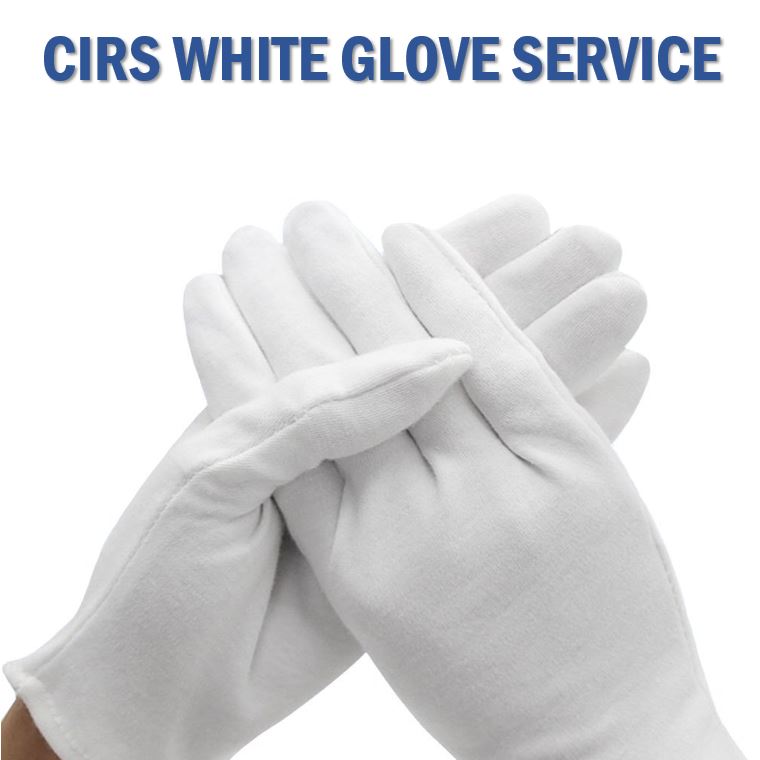

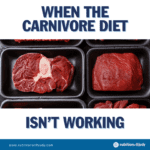
Myra L.
April 19, 2024 at 10:41 amincredible. you are truly a treasure Judy. Thank you for this incredible piece.
Mario
April 20, 2024 at 2:56 pmMakes sense. I remember Shoemaker saying that antifungal paint made mold problem in houses worse, yet he contradicts himself by recommending putting antibacterials on yourself. Remove, not kill – greatly said.
Jeanmarie Todd
April 20, 2024 at 7:00 pmYour research and documentation are just stunning. I don’t suffer from CIRS, thank goodness, but I try to keep up with the issues. I definitely agree with not over-sanitizing the environment. As you stated, bacteria have evolved to survive unfavorable circumstances, and attempting to eradicate them has negative consequences. I was put on Tetracycline for years as a teenage to combat acne, and that led to yeast infections that became chronic and unremitting. I tried to eradicate Candida overgrowth for awhile, and finally figured out that removing sugar, some *limited* use of antifungals, and consuming a variety of probiotic foods is a better strategy. even after over a year on carnivore, I had a flare up of yeast overgrowth and started to read Super Gut by William Davis, MD, and watched many interviews with him, and I’ve started incorporating the L Reuteri yogurt into my life. I’m still meat-based but incorporating fermented and cultured food as much as possible. It didn’t occur to me, until I started reading Super Gut, that eating too low carb for too long could result in permanent changes to the microbiome, and not necessarily for the better. So I’m on what I’d call a modified carnivore diet now, with lots of probiotic foods including sauerkraut or kimchi a few times a week, and L. Reuteri yogurt and kefir daily.
Thanks for all you do.
Colin Tracey
April 20, 2024 at 7:19 pmWow, what a read this was. You can tell you guys put in a lot of effort breaking everything down. Looking forward to seeing more of this stuff in the future. Thank you very much!
Carol Murphy
April 20, 2024 at 8:31 pmThank you so much for your guidance and support. Recently, I’ve found myself overwhelmed by the Actinos protocol, especially since, as you mentioned, my scores have been worsening and my health feels stagnant. Each set of test results without expected improvement has been deeply disheartening. Initially, I experienced some relief with the Shoemaker CSM protocol, but I haven’t seen similar benefits from the Actinos cleaning and hygiene protocols. Despite this, my CIRS doctor has remained singularly focused on Actinos, as he says it’s the primary concern with CIRS.
Reading your article has provided me with both encouragement and immense relief. I am profoundly grateful to you, Judy, and your entire team for your steadfast support and insightful guidance.
Mike Pelletier
April 22, 2024 at 6:40 pmYou wrote “Corynebacterium tuberculosis (C. tuberculosis)” as one of the 2 pathogenic actinos to look out for, which I don’t see on the Envirobiomics test results, did you mean Corynebacterium tuberculostearicum?
Nutrition with Judy
April 25, 2024 at 10:30 amgood catch, it’s a typo. The correct strain is: Corynebacterium tuberculostearicum. We got it right on the section with the 5 strains. We updated it, thank you.
Martha Straw
April 29, 2024 at 3:48 pmThank you for painstakingly compiling this information.
To contribute to your CONS on Defense Shower Gel, I found that using the gel as a shampoo stripped the natural color from my hair leaving it more gray. I thought it was due to stress. The hairstylist pointed out that the color on the strands of hair changed at different locations.